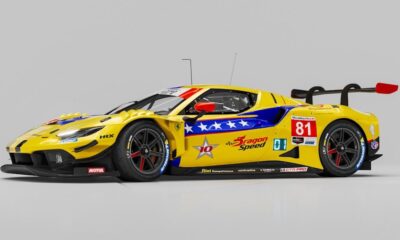
Photo: IMSA
There’s been plenty of discussion and some questions over IMSA’s new officiating and post-race procedures following a drama-filled opening weekend in Daytona.
The launch of the TUDOR United SportsCar Championship and the return of the Continental Tire SportsCar Challenge saw three separate post-session decisions by officials, two of which ended with different winners that had initially celebrated in victory lane.
The most significant came in the Rolex 24, when the No. 555 Level 5 Motorsports Ferrari of Alessandro Pier Guidi was initially penalized for avoidable contact with Markus Winkelhock’s No. 45 Flying Lizard Motorsports Audi on the final lap and was moved back to fourth in class.
However, the ruling was overturned by IMSA’s new supervisory board nearly four hours after the race, handing the win back the GTD class victory to Pier Guidi and co-drivers Townsend Bell, Jeff Segal, Bill Sweedler and Scott Tucker.
The decision came just 72 hours after the GTD pole-sitting No. 48 Paul Miller Racing Audi was sent to the back of the grid due to a rear wing endplate violation, but was later reinstated following a meeting with the board which clarified a line in the technical regulations.
“We have a new procedure in place where we have a group of supervisory officials that can review decisions that we’ve made,” IMSA’s VP of competition and technical regulations Scot Elkins told Sportscar365. “[Reversing a decision] is last thing we ever want to do. But, where a situation we feel that’s appropriate, we have the opportunity to do that. Hopefully that builds confidence in the paddock that we have a chance to do what’s right now.”
Comprised of Elkins, IMSA CEO Ed Bennett, President and COO Scott Atherton, as well as Richard Buck, Mark Raffauf, Gary Cummings, Steve Sewell, Jeff Smallwood, Charlie Cook and Race Director Paul Walter, not all members on the supervisory board are typically involved in the process, Elkins said.
Elkins said the supervisory board is similar to the stewards in the ALMS, which made independent rulings following a review of a particular incident.
In the case of the controversial end to the Rolex 24, the board met to evaluate the penalty imposed on the No. 555 Ferrari, which was initially deemed avoidable contact by the Race Director.
There’s no clear-cut protocol that would escalate a ruling to be reviewed. However, Elkins said it’s not induced by teams or manufacturers and initiated by IMSA themselves. Race procedures, for instance, cannot be protested.
“It doesn’t mean that any decision can be reviewed,” he said. “It’s not like that. The review process is set up so that it’s an internal one. There was no protest or appeal or any of that. It’s something that gives us the opportunity to kind of gut-check ourselves to make sure doing what we need to do.”
While the process with the supervisory board took nearly four hours to complete, long after the Flying Lizard drivers had already left the circuit, Elkins is hopeful for a more streamlined procedure in the future.
“I think that since this was the first time this type of procedure happened, it obviously took longer that we care to see,” he said. “There’s lots of things we can learn from this in terms of making people aware sooner and trying to do things in a little bit different way.”
As for the actual incident that came into question, Elkins said IMSA’s officiating process is a mix from what was seen in both series in years’ past.
GRAND-AM has typically been more lenient in allowing slight contact, while the ALMS had seen stiffer penalties for most forms of on-track incidents. A new protocol of a stop-and-hold-plus 75-second penalty was in place for GT-class cars at Daytona, the same time penalty which was originally given to the No. 555 Ferrari.
“Every incident is different,” Elkins said. “You try to be as consistent as you can in terms of making the calls from Race Control. What we’ve tried to do over the past couple of years is merge the philosophies between GRAND-AM and ALMS. What happened in Daytona was a part of that.”
Friday’s BMW Performance 200 CTSC race also had its fair share of post-race drama, as the GS class-winning No. 96 Turner Motorsport BMW M3 of Bill Auberlen and Paul Dalla Lana was excluded for an unapproved airbox, handing the win to the No. 48 Fall-Line Motorsports BMW, some three hours after the checkered flag.
While GRAND-AM had previously penalized post-race technical infractions with only a loss of points and prize money, Elkins confirmed IMSA has adopted a pre-2013 ALMS-style exclusion procedure for both series this year.
It’s a reversal of the philosophy which was also used in the ALMS last year, which let teams keep their finishing position despite receiving a post-race infraction.
“Working with the GRAND-AM model last year and the ALMS model [in previous years], we came to the conclusion that when an infraction is found afterwards, that an exclusion is really the only option for us,” Elkins said.
“It’s the most fair thing for all competitors, in terms of being able to celebrate the win if the car is found to have some kind of infraction. It’s not really fair for them to keep that.”
























